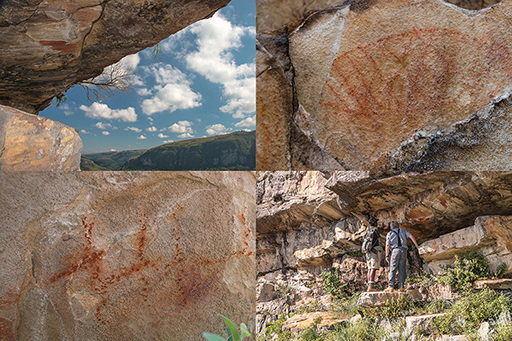
ain, wind and heat erode the rock formations of Campos Gerais to form shelters, in which can be seen examples of rock art — paintings executed in a base of mineral pigments and organic substances, animal or vegetal. The most-used colors were red and brown, produced by crushing fragments of hematite (a form of iron oxide).
The paintings occur in the form of panels or isolated figures on walls and ceilings, in places both easy and hard to reach. The images show two very characteristic forms: one is naturalistic, focusing on animals; the other is geometrical, and circles, lines, and points predominate. In the first case, common figures are cervids (deer), boars, capybaras, foxes, snakes and birds. There are representations of hunting traps. Human figures rarely appear.
The paintings are attributed to a population of nomadic hunter-gatherers who started travelling the countryside about 4,000 years ago. They went on seasonal excursions to hunt for game, for fishing, for colelcting fruits and other natural products. The region supplied all they needed to survive. Game and fish were abundant due to the great hydrographic network and the different environments, such as the groves and gallery forests, with their concentrations of animal life. Woodland fruits, like pitanga, jerivá, guabiroba e araçá, pinhão (araucária seed), honey and larvae must have made up a part of the diet of these human groups. In these places they must have also collected vegetal fibers, resins, and, very probably, medicinal plants and pigments.
At this time, there are about 70 known rock painting sites in the municipalities of Piraí do Sul, Ponta Grossa, Tibagi, Ventania, Sengés, and Jaguariaíva.
click on picture
to enlarge